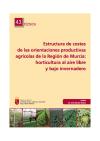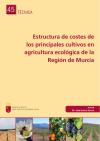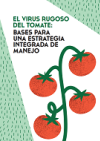Media library
Documentary, graphic and/or audiovisual knowledge objects are offered here, offering information on various sectors and topics. Use the keyword search or search filters to access current audiovisual and documentary knowledge objects useful for your implementation.
If you have any questions or suggestions, please contact us here.

Phytosanitary strategies in tomato
Strategies for the use of phytosanitary products in tomte cultivation

Cost structure of agricultural production areas in the Region of Murcia: open-air and greenhouse horticulture
Publication dedicated to regional horticultural crops, both outdoors and under protected and greenhouse conditions.

Cost structure of the main crops in organic farming in the Region of Murcia
Document describing the main guidelines for regional organic farming in Murcia

Tomato rugose virus: bases for an integrated management strategy
Document with information on epidemiological aspects—such as plant infection, virus spread, alternative hosts, virus persistence in the environment, etc.—that are essential for understanding and framing.
Plant pest and disease advisories, beware of the possible introduction or presence of Tomato Rugose Fruit Virus (ToBRFV)
Organism under community emergency measures that causes symptoms on leaves and damage to tomato fruits
Plant pest and disease alerts: Presence of a large number of individuals of Mythimna unipuncta, a grass defoliating caterpillar.
A very voracious and polyphagous defoliating caterpillar that can affect both forage and horticultural crops, with prairies and grasslands, along with corn, being the most affected.
Plant Pest and Disease Advisories: Guatemalan Potato Moth Tecia solanivora
Tecia solanivora is considered a quarantine organism due to the potential phytosanitary risk it represents, constituting a serious threat to potato production by affecting and rendering tubers worthless, either during cultivation or in storage.
Notice of the first outbreak of Tomato Rugose Fruit Virus (ToBRFV) in the Region of Murcia (September 27, 2021)
Tomato brown rugose fruit virus (ToBRFV), a member of the tobamovirus family, was first detected in tomato crops in Israel in 2014 and in Europe in Germany in 2018. In 2019, it experienced a significant expansion when it was isolated in Italy, the Netherlands, Greece, and other Member States.
Information note and management recommendations: thrips damage to citrus, persimmon, and pomegranate.
Given the damage caused by thrips observed since May on leaves and fruit in various citrus, persimmon and pomegranate crops and the confirmation of the presence of Scirtothrips aurantii Faure in certain areas, the following recommendations have been considered appropriate:
Recommendations for the strategy to control leaf necrosis in persimmons
During the 2019 campaign, control failures were detected in some plots in the Ribera Alta region (Alzira, Benimuslem, Guadassuar, and Massalavés). Systematic surveys carried out in 2020 revealed that the resistance of the fungus Plurivorosphaerella nawae to the QoI group of fungicides (strobilurins) was present in most persimmon-producing areas in the province of Valencia.
Technical information on the potato flea beetle (Epitrixs pp.)
The potato flea beetle refers to several species of the Epitrix genus, which are primarily considered pests of potato crops, although they can also affect other Solanaceae crops such as peppers, tomatoes, and eggplants.
Fact sheet on Scirtothrips dorsalis
Scirtothrips dorsalis Hood, known as chili thrips, tea yellows, or flower thrips, is a harmful organism classified as a quarantine pest. It is an insect native to southern and eastern Asia and has a wide range of host plants (more than 150 species), including commercial crops such as beans, tomatoes, eggplant, cucumber, onion, and peppers.
Scirtothrips aurantii, information note and management recommendations, damage caused by thrips in citrus, persimmon and pomegranate.
Given the damage caused by thrips observed since May on leaves and fruit in various citrus, persimmon and pomegranate crops and the confirmation of the presence of Scirtothrips aurantii Faure in certain areas, the following recommendations have been considered appropriate:
Potato flea beetle (Epitrix papa)
Defoliating beetle of American origin that owes its name to the ability of adults to jump when disturbed. It was detected in Europe in 2008, in Portugal. In Spain, it was detected in Galicia in 2009, and in Asturias in 2014. It is considered a quarantine organism due to the loss of commercial value of tubers.
Zebra Chip and its vectors
Candidatus liberibacter solanacearum (CLso) is the bacterium that causes the potato disease known as "Zebra chip." Its name derives from the pattern of light and dark stripes on the tuber, resembling zebra stripes, which are more evident after frying. Five CLso haplotypes (A, B, C, D, E) have been described.
Controlling the green midge in vines
The "green gnat" pest is considered a secondary pest of vines. It includes a group of sucking insects from the leafhopper family that affect other cultivated and wild plants.
Contingency Plan for ToBRFV, Tomato Brown Rugose Fruit Virus (Tomato Brown Rugose Fruit Virus) in the Autonomous Community of Extremadura
Tomato brown rugose fruit virus (Tobamovirus, ToBRFV) was first identified in tomatoes in Jordan in 2015, and recent outbreaks have occurred in Italy, Mexico, Turkey, China, the United Kingdom, the Netherlands, Greece, Spain, and France, where the virus is of great concern to tomato and pepper growers.
Illustrated guide to pests and natural enemies in greenhouse horticultural crops
The significant activity of protected horticulture in the province of Almería undoubtedly contributes to the supply of high-value products to domestic and export markets and generates significant social and economic benefits.
Control of Tuta absoluta in tomato
Since its detection in mid-2006, it has been the most significant tomato pest due to damage to plants and fruit, difficulty in control, and rapid population growth.




